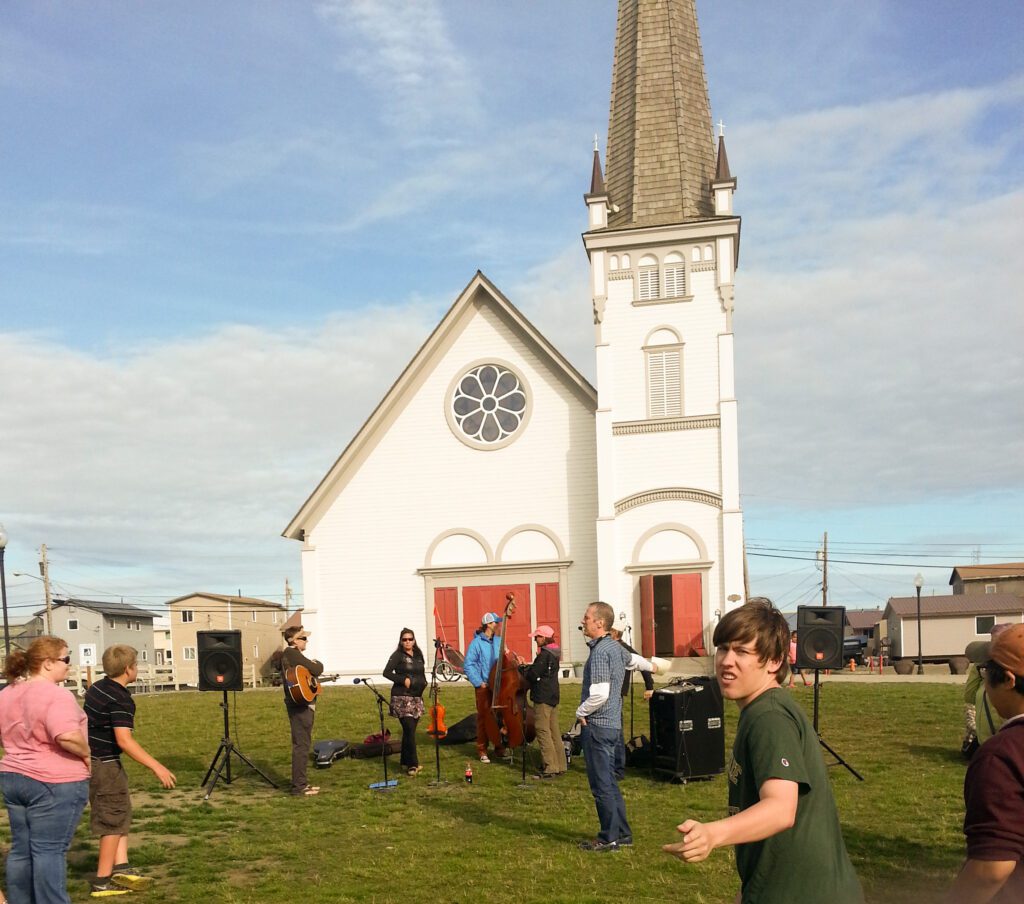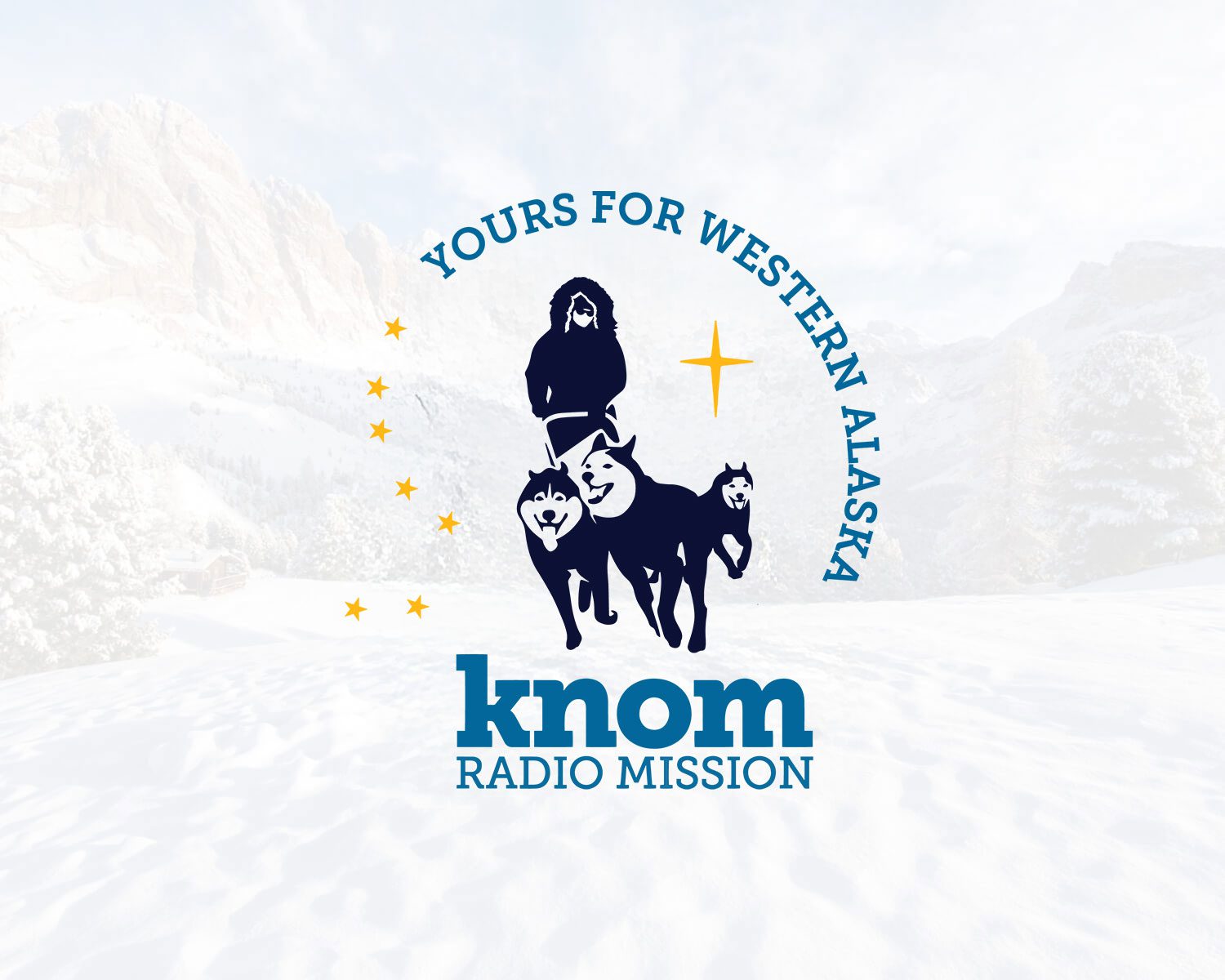
The first rule of mushing is… you can’t help but talk about mushing.
I’m not the worlds biggest fan of dogs – I’ve always considered myself a cat person, actually. But this weekend, I fell in love with 12 dogs that pulled a sled I was riding – even after they pulled me and their owner, Rolland, through a snowdrift and the sled “was upsot” (Christmas Carols in February are slightly less timely, I suppose… that’s from Jingle Bells.)
Let’s back up a little – before the untimely spilling, I had absolutely no idea what to expect. I wasn’t even supposed to mush this weekend – it was Margaret’s turn – but she became sick, and passed the phone to me to talk to Rolland. He’d been inviting us to go with him for several weeks, and since each dog sled can carry only two people, it’s a slow process to go through the volunteers. On the phone, though, Rolland told me that Deb, his wife, would be picking me up via snow machine – and we’d traverse out onto the trails around Nome to find him and the dogs. The thing about snow machines is that they’re a lot faster than dogsleds – but even with the extra speed, the sheer number of trails around Nome meant that we spent about 30 minutes searching the tundra for Rolland. I can’t imagine trying to meet up with someone without the additional speed and guidance of the shortwave radios they used to talk to each other!
Once we found Rolland – i.e. saw a vague blur in the distance that was shaped like the humps of a sea serpent, but in snow… a snow serpent? – we stopped the machine and let him catch up with us, so that the dogs wouldn’t be frightened. Each dog got a bowl of food – hamburger meat mixed with fat and dry dogfood – and time to rest, eat snow, and generally be happy. And happy they were – these dogs took time to roll in the snow, play around a little bit, even though they weren’t removed from their harness. When stopped, they had lots of room to roam, but were still reasonably ordered. The two lead dogs – Junior and Ernie – took turns being attached to the snow machine so as to not lead the whole team away from the sled. Lots of care was taken to make sure the sled was “hooked in,” with anchors made out of… hooks. Three prong hooks that grab the snow. The dogs like to run so much that if the care isn’t taken, they’ll just run away with the sled, and no direction!
After the dogs were fed and rested a bit, Rolland suggested I hop on the sled. Now, the sled itself is made of wooden slats connected to a metal frame. The frame is pretty light, but robust – it reminds me of early bicycle construction, when wood and metal were mixed more freely. I’m sure racing sleds are made with polycarbonate materials, but this seems… right. Like an old school way of connecting with the dogs, with the land around you.
The second rule of mushing is… you can’t help being connected with the land.
I hopped onto the sled, and Rolland took up his position on the back, handing me the anchors while he carefully kept his foot on the “brake” – a series of metal cleats that are pushed into the ground by the simple act of stepping on a spring-tensioned bar. He called out to the dogs, “Ready!” and they immediately lept into position, pulling against their harnesses with an eagerness to get going. Two very young dogs near the back had apparently decided that they were on the wrong sides, and instead of pulling forward and outward, were instead pulling forward and in, leaning against each other for support. Now, I half expected Rolland to swap their sides, but he just shook his head and called “Hike Hike!” while releasing the brake.
Yes. “Hike Hike!” is the command to go forward. It used to be “Marche!” – which English speakers heard as “Mush!” – but few mushers today are French, and no one can pronounce the French word consistently except the French. So, when standards for dogs were being decided back in the Gold Rush times (early 20th century, and through the 1930s), the standard became Hike! to start. Three other commands exist as standards too – which Rolland taught me using the acronym HOG, “Haw” “On-by” “Gee”. Haw means left, On-by means keep going, ignore what’s around you, and Gee means right. They’re used at intersections of trails – and those intersections can get pretty confusing. I still don’t know exactly where the trails were that we took, save that they were marked, and I saw the Sun hit all sides of the dogs and my face several times, so there were circles involved.
Finally, about 90 minutes into the adventure of travelling at reasonable speeds across a reasonably snowy landscape, Rolland stopped the team and asked if I was interested in mushing. “YES!” I exclaimed, and he gave a quick run through of commands, and switched places with me. Now, I got to stand at the back of the sled, and adjust my weight to keep the sled following properly. The feel of this is something like skiing, except reversed – you shift your weight in the direction you want to go instead of the opposite direction. Not realizing that led to a few encounters with low-hanging brush – there being no other kind in Nome – that Rolland thankfully brushed off due to my inexperience. Rolland directed me when to call commands, and we took the team by Dredge #5 – one of the largest gold dredges in the world. It’s beautiful to see the dredge in the chilly sunlight of the Tundra!

The third rule of mushing is… to pay attention to the dogs AND the landscape.
As we neared the end of the run, some three hours after I got on the sled in the first place, Rolland and I switched places again, and we went through a narrow channel. It was clear that a snow machine had taken this same route, and had gotten stuck, which led to a choppy trail, leaning the sled significantly as the dogs took us through a turn in the channel. And this is where we fell – and subsequently were dragged for a few meters, until the sled buried itself (and us, who were hanging on!) sufficiently to halt the dogs. The sled fell to its side, which meant that I spilled out of it, while Rolland was dragged further. We both grabbed on to the upright bar that serves as a back to the “cargo” portion of the sled, and tried to keep it together. Sadly, every time we got the sled nearly upright, the dogs would take off… and we’d have to hang on, or run quickly to catch up. Finally, we worked together to get the sled upright and the brake pushed in, and the dogs waited for us to get situated again. I found out later that Laura, Jeff, and Chris were watching from the Collins’ house in the Nome “Suburb” of Icy View – though they didn’t know it was us that fell until later.
Rolland brought the team back to their kennel, by the Nome airport, and I helped unhook the dogs from the harness and return them to their shelters. The harness is a new design for Rolland, that gives the dogs a lot of freedom, and pulls on their shoulders instead of back or neck. To unhook it, I had to straddle the dogs, one at a time, and hold them with a gentle pressure until I could direct them to their proper shelter. At this point, they all were fed again – a well deserved meal, since they’d been working hard to pull an extra-heavy sled for nearly 30 miles. Rolland checked his pocket to discover that his shortwave radio had gone missing – so we hopped onto the snow machine, and rode it back at high speed to the point where we had spilled. There, in the snow, was his radio – and I got to experience medium-speed snow machine travel. We didn’t go more than 60 mph, but 60 is plenty fast when you’re on the back of a machine rocketing across uneven terrain. It was lots of fun, but also really telling for just how impressive the Iron Dog race is, where racers take snow machines all across Alaska.
So… that’s my story of my first time mushing. It began and ended with snow machines – and a bit of wind burn on my nose – but I wouldn’t trade that experience for anything. It was fun to connect with the land in both the old and the new ways, and to spend time with excited, happy dogs who got to run to their hearts content, and another human being who was happy to see them run as well.







